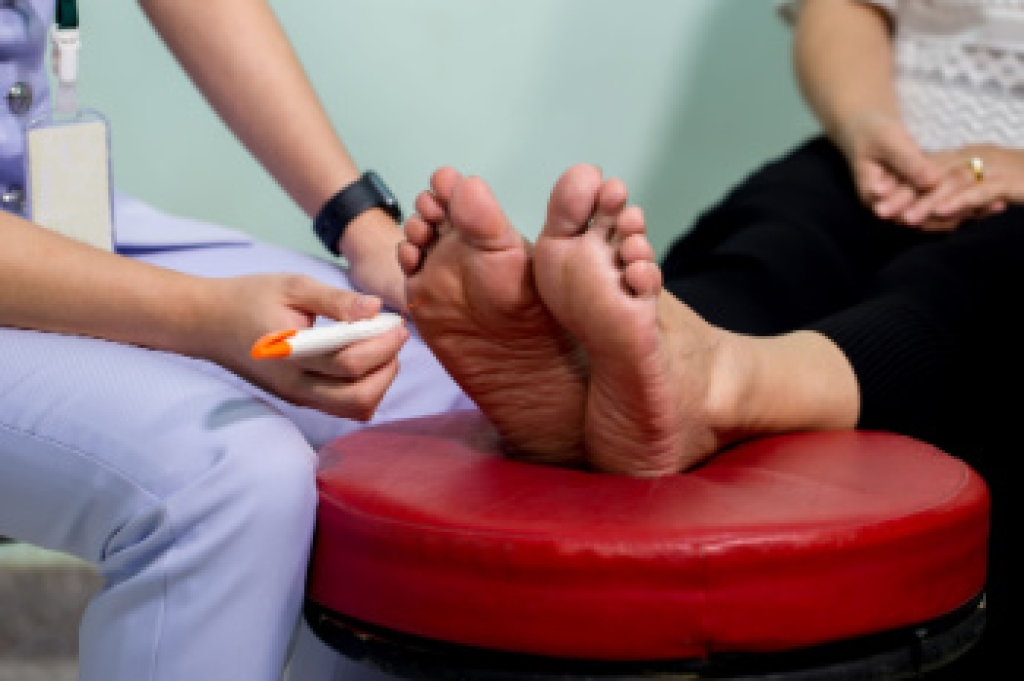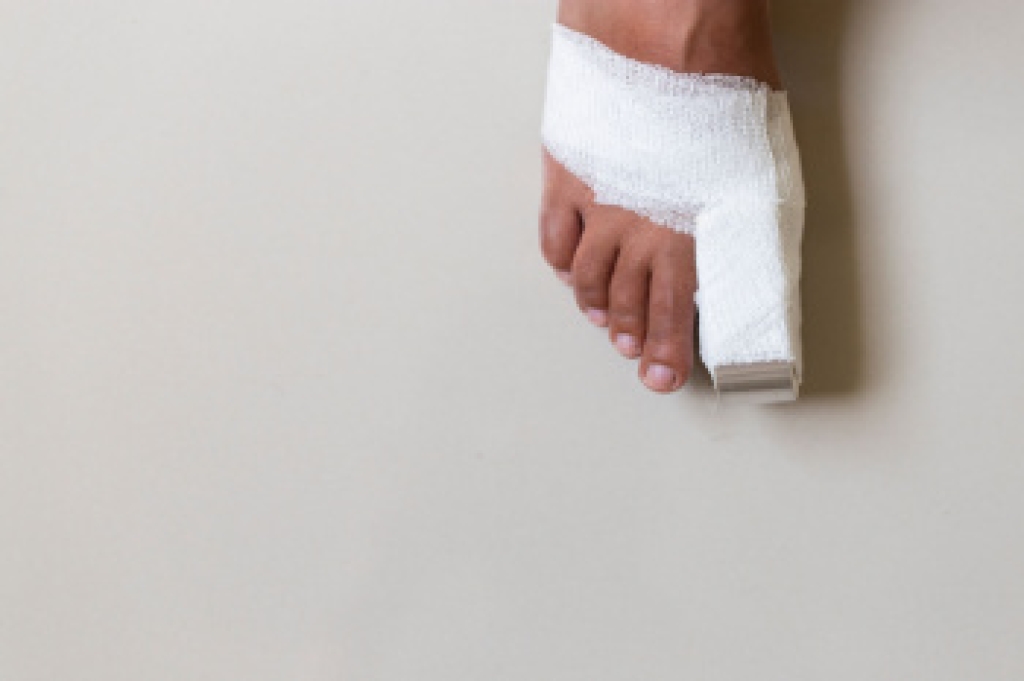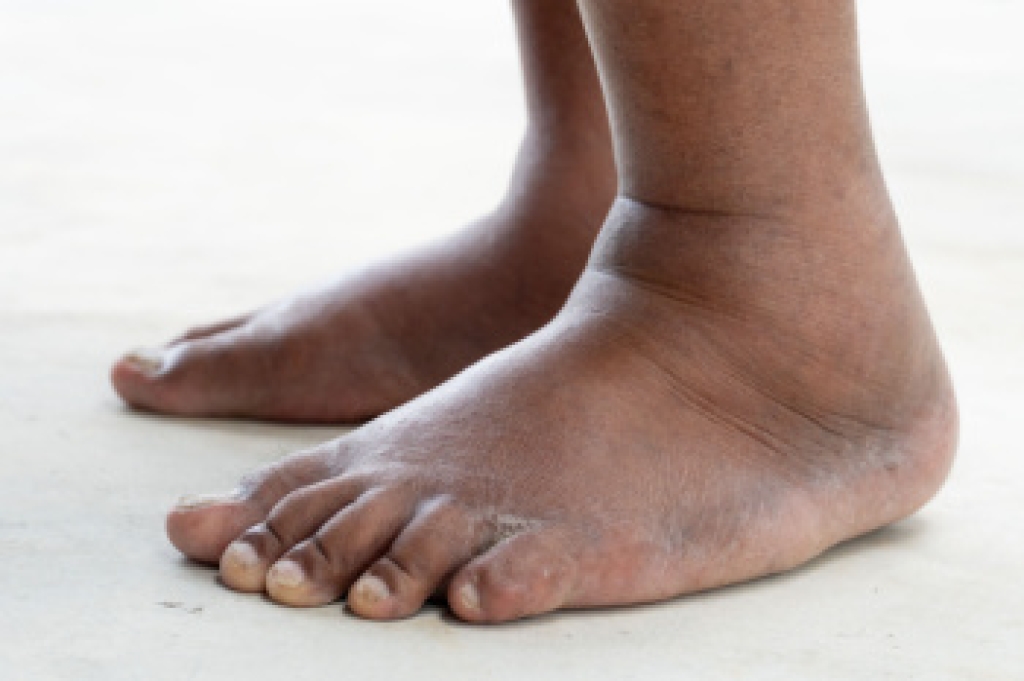Connect With Us
Blog
Blog
Five Nerve-Related Causes of Foot Pain

Nerve-related causes of foot pain include several conditions that directly affect the nerves in the toes, arches, or ankles. Morton's neuroma involves a thickening of the nerve between the toes, often creating burning pain or a feeling of pressure under the foot. A pinched nerve can develop from swelling, trauma, or shoes that lack adequate space, leading to sensitivity and discomfort. Tarsal tunnel syndrome occurs when the tibial nerve near the ankle becomes compressed, producing numbness, cramping, or shooting pain that travels through the arch or sole. Diabetic peripheral neuropathy results from long-term nerve damage caused by high blood sugar, which frequently begins with pain or reduced feeling in the toes and progresses through the foot. Nerve pain in the foot can also come from a herniated disc in the lower back, which irritates spinal nerves and sends pain down into the foot. If you are experiencing this type of foot pain, it is suggested that you schedule an appointment with a podiatrist for an exam and appropriate treatment.
Neuropathy
Neuropathy can be a potentially serious condition, especially if it is left undiagnosed. If you have any concerns that you may be experiencing nerve loss in your feet, consult with Stephen Boykins, DPM from SoCal Podiatry, P.C.. Our doctor will assess your condition and provide you with quality foot and ankle treatment for neuropathy.
What Is Neuropathy?
Neuropathy is a condition that leads to damage to the nerves in the body. Peripheral neuropathy, or neuropathy that affects your peripheral nervous system, usually occurs in the feet. Neuropathy can be triggered by a number of different causes. Such causes include diabetes, infections, cancers, disorders, and toxic substances.
Symptoms of Neuropathy Include:
- Numbness
- Sensation loss
- Prickling and tingling sensations
- Throbbing, freezing, burning pains
- Muscle weakness
Those with diabetes are at serious risk due to being unable to feel an ulcer on their feet. Diabetics usually also suffer from poor blood circulation. This can lead to the wound not healing, infections occurring, and the limb may have to be amputated.
Treatment
To treat neuropathy in the foot, podiatrists will first diagnose the cause of the neuropathy. Figuring out the underlying cause of the neuropathy will allow the podiatrist to prescribe the best treatment, whether it be caused by diabetes, toxic substance exposure, infection, etc. If the nerve has not died, then it’s possible that sensation may be able to return to the foot.
Pain medication may be issued for pain. Electrical nerve stimulation can be used to stimulate nerves. If the neuropathy is caused from pressure on the nerves, then surgery may be necessary.
If you have any questions, please feel free to contact our offices located in Downey and Moreno Valley, CA . We offer the newest diagnostic and treatment technologies for all your foot care needs.
Getting Back in the Game After a Broken Toe

A fractured toe may seem minor, but it can significantly affect balance, stability, and athletic performance. These injuries often occur from direct impact, stubbing the toe, or repetitive stress during sports. Recovery depends on the severity and location of the break, with healing typically taking several weeks. Rest, protective footwear, and sometimes taping or splinting allow the bone to heal properly. Rushing back to sports too soon can delay recovery or lead to re-injury. Once pain and swelling subside, gradual return to movement and strength training helps restore flexibility and coordination. Wearing supportive shoes, and, in some cases, orthotics can reduce pressure on the healing area. If you are an athlete and have a broken toe, it is suggested that you schedule an appointment with a podiatrist before resuming full activity to ensure the toe has healed completely, and to receive guidance on safe re-entry into training and competition.
A broken toe can be very painful and lead to complications if not properly fixed. If you have any concerns about your feet, contact Stephen Boykins, DPM from SoCal Podiatry, P.C.. Our doctor will treat your foot and ankle needs.
What to Know About a Broken Toe
Although most people try to avoid foot trauma such as banging, stubbing, or dropping heavy objects on their feet, the unfortunate fact is that it is a common occurrence. Given the fact that toes are positioned in front of the feet, they typically sustain the brunt of such trauma. When trauma occurs to a toe, the result can be a painful break (fracture).
Symptoms of a Broken Toe
- Throbbing pain
- Swelling
- Bruising on the skin and toenail
- The inability to move the toe
- Toe appears crooked or disfigured
- Tingling or numbness in the toe
Generally, it is best to stay off of the injured toe with the affected foot elevated.
Severe toe fractures may be treated with a splint, cast, and in some cases, minor surgery. Due to its position and the pressure it endures with daily activity, future complications can occur if the big toe is not properly treated.
If you have any questions, please feel free to contact our offices located in Downey and Moreno Valley, CA . We offer the newest diagnostic and treatment technologies for all your foot care needs.
Common Foot Injuries in Golf and How to Prevent Them

Golf may seem low impact, but the repetitive motions and long hours on your feet can lead to several foot injuries. Plantar fasciitis causes heel pain from inflammation of the tissue supporting the arch, while metatarsalgia leads to pain in the ball of the foot from excessive pressure during swings. Additionally, tendonitis can develop from overuse of the tendons that stabilize the foot and ankle, and stress fractures may occur from repetitive strain on the bones. A podiatrist can diagnose the cause of your pain, recommend custom orthotics, and create a treatment plan to restore comfort and mobility. If foot pain is affecting your golf game, it is suggested that you consult a podiatrist who can provide expert care and effective recovery solutions.
Ankle and foot injuries are common among athletes and in many sports. They can be caused by several problems and may be potentially serious. If you are feeling pain or think you were injured in a sporting event or when exercising, consult with Stephen Boykins, DPM from SoCal Podiatry, P.C.. Our doctor will assess your condition and provide you with quality foot and ankle treatment.
Common Injuries
The most common injuries that occur in sporting activities include:
- Achilles Tendonitis
- Achilles Tendon Rupture
- Ankle Sprains
- Broken Foot
- Plantar Fasciitis
- Stress Fractures
- Turf Toe
Symptoms
Symptoms vary depending upon the injury and in some cases, there may be no symptoms at all. However, in most cases, some form of symptom is experienced. Pain, aching, burning, bruising, tenderness, tightness or stiffness, sensation loss, difficulty moving, and swelling are the most common symptoms.
Treatment
Just as symptoms vary depending upon the injury, so do treatment options. A common treatment method is known as the RICE method. This method involves rest, applying ice, compression and elevating the afflicted foot or ankle. If the injury appears to be more serious, surgery might be required, such as arthroscopic or reconstructive surgery. Lastly, rehabilitation or therapy might be needed to gain full functionality in the afflicted area. Any discomfort experienced by an athlete must be evaluated by a licensed, reputable medical professional.
If you have any questions please contact our offices located in Downey and Moreno Valley, CA . We offer the newest diagnostic and treatment technologies for all your foot and ankle needs.
Reasons Your Feet May Be Swollen

Swollen feet are a common problem that can affect people of all ages. The reasons may range from temporary fluid buildup in hot weather or pregnancy to more serious health concerns that involve circulation or injury. The medical term for swelling caused by trapped fluid is edema. It often appears in the feet and ankles, causing stretched skin and dimpling when pressed. Injuries like ankle sprains can also lead to sudden swelling, restricting mobility, and causing pain. In pregnancy, swelling may occur gradually, but if it becomes severe and sudden, it could signal preeclampsia, a condition that requires immediate medical care. Prolonged standing or wearing shoes that lack adequate support can also contribute to swelling of the feet. A podiatrist can carefully evaluate the feet to determine the underlying cause and provide treatment to protect long-term foot health. If you suffer from excessive or unusual swelling in the feet, it is suggested that you make an appointment with a podiatrist for an exam and treatment.
Swollen feet can be a sign of an underlying condition. If you have any concerns, contact Stephen Boykins, DPM of SoCal Podiatry, P.C.. Our doctor can provide the care you need to keep you pain-free and on your feet.
Swollen feet are a common ailment among pregnant women and people who stand or sit for extended periods. Aging may increase the possibility of swollen feet and patients who are obese often notice when their feet are swelling too. There may be medical reasons why swollen feet occur:
- Phlebitis - A condition that causes the veins to become inflamed and can also cause leg pain.
- Liver disease - This may lead to low blood levels of albumin which is a protein. This can cause fluid in the blood to pass into the tissues and several areas of the body can become swollen.
- Heart failure - When the heart doesn’t pump properly the blood that is normally pumped back to the heart can pool in the veins of the legs causing swollen feet.
- Kidney disease - One of the main functions of the kidneys is releasing excess fluid in the body. This type of condition can make it difficult for the kidneys to function properly, and as a result the feet may become swollen.
- Deep-vein thrombosis (DVT)- This is a serious condition where blood clots form in the veins of the legs. They can block the return of blood from the legs to the heart which may cause the feet to swell. It is important to be treated by a podiatrist if this condition is present.
Swollen feet can also be caused by bone and tendon conditions, including fractures, arthritis, and tendinitis. Additionally, there may be skin and toenail conditions and an infection may cause the feet to swell. Patients who take medicine to treat high blood pressure may be prone to getting swollen feet.
Many patients elevate their feet to help relieve the swelling and this is generally a temporary remedy. When a podiatrist is consulted the reason behind the swelling can be uncovered and subsequently treated.
If you have any questions please contact our offices located in Downey and Moreno Valley, CA . We offer the newest diagnostic and treatment technologies for all your foot and ankle needs.
Blog Archives
- 2025
- 2024
- 2023
- 2022
- 2021

